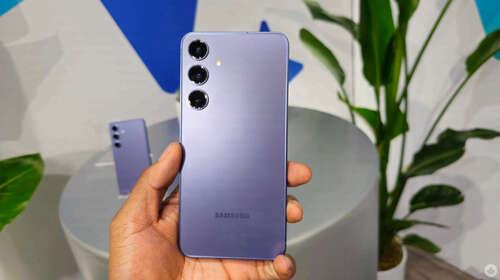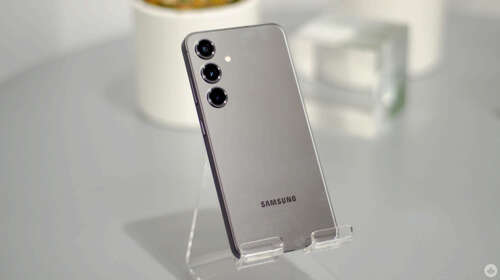At Samsung’s Galaxy S24 Unpacked event in San Jose, California, the company unveiled its new flagship S series devices: the Galaxy S24, the Galaxy S24+ and the Galaxy S24 Ultra. I had the opportunity to go hands-on with each smartphone before the tech giant’s main event.
While the overall hardware design resembles its predecessors, this year, the South Korean tech maker is focusing on its new ‘Galaxy AI.’ Galaxy AI uses both on-device and Cloud-based AI, depending on the feature you’re using.
Shockingly, we didn’t hear anything about Bixby, Samsung’s voice-activated assistant, at this event. While I focus on the Galaxy S24 Ultra in this hands-on, the Galaxy S24 and S24+ offer similar AI features (so when I’m discussing AI, it applies to all three devices).
Samsung hardware
Before getting into Samsung’s AI efforts, let’s dive into specs.
Dynamic LTPO AMOLED 2X, 120Hz, HDR10+, 2600 nits (peak)
Dynamic LTPO AMOLED 2X, 120Hz, HDR10+, 2600 nits (peak)
Dynamic LTPO AMOLED 2X, 120Hz, HDR10+, 2600 nits (peak)
Qualcomm Snapdragon 8 Gen 3
Qualcomm Snapdragon 8 Gen 3
Qualcomm Snapdragon 8 Gen 3
50-megapixel, f/1.8, 24mm (wide), 10-megapixel, f/2.4, 70mm (telephoto), 12-megapixel, f/2.2, 13mm, 120˚ (ultrawide)
50-megapixel, f/1.8, 24mm (wide), 10-megapixel, f/2.4, 70mm (telephoto), 12-megapixel, f/2.2, 13mm, 120˚ (ultrawide)
200-megapixel, f/1.7, 24mm (wide), 50-megapixel, (periscope telephoto), 10-megapixel, f/2.4, 70mm (telephoto)
12-megapixel, f/2.2, 26mm (wide)
12-megapixel, f/2.2, 26mm (wide)
12-megapixel, f/2.2, 26mm (wide)
Wi-Fi 802.11 a/b/g/n/ac/6e, tri-band, Wi-Fi Direct,
Wi-Fi 802.11 a/b/g/n/ac/6e/7, tri-band, Wi-Fi Direct
Wi-Fi 802.11 a/b/g/n/ac/6e/7, tri-band, Wi-Fi Direct
Fingerprint (under display, ultrasonic), accelerometer, gyro, proximity, compass, barometer
Fingerprint (under display, ultrasonic), accelerometer, gyro, proximity, compass, barometer
Fingerprint (under display, ultrasonic), accelerometer, gyro, proximity, compass, barometer
Nano-SIM and eSIM or Dual SIM
Nano-SIM and eSIM or Dual SIM
Nano-SIM and eSIM or Dual SIM
Dynamic LTPO AMOLED 2X, 120Hz, HDR10+, 2600 nits (peak)
Dynamic LTPO AMOLED 2X, 120Hz, HDR10+, 2600 nits (peak)
Dynamic LTPO AMOLED 2X, 120Hz, HDR10+, 2600 nits (peak)
Qualcomm Snapdragon 8 Gen 3
Qualcomm Snapdragon 8 Gen 3
Qualcomm Snapdragon 8 Gen 3
50-megapixel, f/1.8, 24mm (wide), 10-megapixel, f/2.4, 70mm (telephoto), 12-megapixel, f/2.2, 13mm, 120˚ (ultrawide)
50-megapixel, f/1.8, 24mm (wide), 10-megapixel, f/2.4, 70mm (telephoto), 12-megapixel, f/2.2, 13mm, 120˚ (ultrawide)
200-megapixel, f/1.7, 24mm (wide), 50-megapixel, (periscope telephoto), 10-megapixel, f/2.4, 70mm (telephoto)
12-megapixel, f/2.2, 26mm (wide)
12-megapixel, f/2.2, 26mm (wide)
12-megapixel, f/2.2, 26mm (wide)
Wi-Fi 802.11 a/b/g/n/ac/6e, tri-band, Wi-Fi Direct,
Wi-Fi 802.11 a/b/g/n/ac/6e/7, tri-band, Wi-Fi Direct
Wi-Fi 802.11 a/b/g/n/ac/6e/7, tri-band, Wi-Fi Direct
Fingerprint (under display, ultrasonic), accelerometer, gyro, proximity, compass, barometer
Fingerprint (under display, ultrasonic), accelerometer, gyro, proximity, compass, barometer
Fingerprint (under display, ultrasonic), accelerometer, gyro, proximity, compass, barometer
Nano-SIM and eSIM or Dual SIM
Nano-SIM and eSIM or Dual SIM
Nano-SIM and eSIM or Dual SIM
The Galaxy S24 Ultra marks one of the biggest changes in a Samsung flagship in the last few years by ditching the 10x zoom lens that debuted in the Galaxy S21 Ultra and has been a feature of the Ultra line ever since. Instead, Samsung’s S24 Ultra now uses a 50-megapixel shooter with a 5x optical lens. While some might consider this a downgrade, Samsung utilizes pixel binning and cropping to get a 10x optical-like photo at 12-megapixels. When a representative from the company showed me this at the hands-on briefing, I compared images to the S23 Ultra’s, and the quality looked nearly identical.
That said, you could argue that the Galaxy S24 Ultra snaps a better 10x zoom photo (I need to do more testing before making a definitive statement). Other cameras include a 200-megapixel primary shooter, a 10x optical camera and a 12-megapixel front-facing shooter.
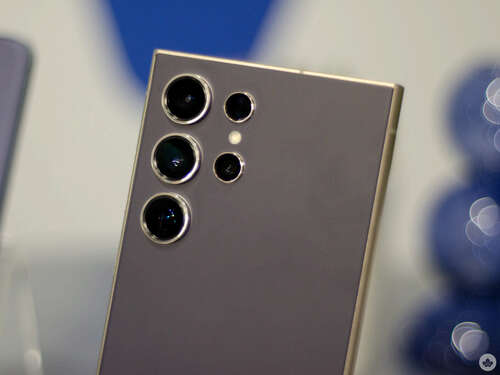
The Galaxy S24 Ultra also features a flatter display than its predecessor, which makes the panel look even more squared off. I’ve always been a fan of curved displays, but I can see why people prefer this flat screen; it’s similar to what Apple offers with the iPhone and still looks great. The handset sports a Titanium frame that looks great in ‘Titanium Gray,’ ‘Titanium Black’ and my favourite, ‘Titanium Yellow,’ but in ‘Titanium Violet, ‘the frame’s colour looks a bit off-putting.
The Galaxy S24 Ultra’s 6.8-inch display sports a QHD+ resolution and a 120Hz refresh rate that can dip as low as 1Hz when viewing images. The S24 Ultra can also reach up to 2,600 nits of brightness, which is much better than the S23 Ultra’s 1,750 nits of brightness.
“Samsung’s entire Galaxy s24 lineup really looks and feels like an iPhone, which many people might have an issue with.”
Other features include 12GB of RAM with up to 1TB of storage, a 5,000mAh battery, One UI 6.1 built on Android 14 and IP68 water and dust resistance.
On the other hand, the Galaxy S24 and S24+ feature a few more changes than their predecessors. The S24 sports a 6.2-inch FHD+ panel, which is slightly bigger than the S23’s screen. The S24+ also has a slightly bigger display, measuring 6.7 inches instead of 6.6 inches, and the S24+ gets a boost in display quality and now offers a QHD+ resolution.
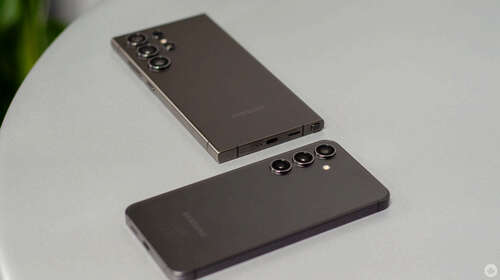
While the S24 doesn’t feature a RAM boost and sticks with 8GB of RAM and up to 256GB of storage, the Galaxy S24+ now features 12GB of RAM and comes in 256GB and 512GB of storage options. Both handsets also feature bigger batteries, with the S24 now sporting a 4,000mAh battery and the S24+ getting a 4,900mAh power cell. Camera-wise, we’re looking at the same shooters, including a 50-megapixel primary camera, a 10-megapixel optical with 3x zoom and a 12-megapixel ultrawide.
Samsung’s entire Galaxy s24 lineup really looks and feels like an iPhone, which many people might have an issue with. However, the design makes a lot of sense if you’re an iPhone user considering switching to Android — a more familiar-looking device might persuade you. It’s also interesting that the Galaxy S24+ is getting a boost in RAM and pixel resolution, making it more of a flagship device and in the middle ground between the S24 Ultra and the base model.
Galaxy S24 series 🤝 Galaxy AI
Samsung’s selling point this year is its various Galaxy AI features. The company is using on-device AI, combined with its Samsung Gauss Language and Samsung Gauss Image models that can answer questions like ChatGPT. Its key features include ‘Live Translate,’ ‘Interpreter,’ ‘Note Assist,’ ‘Transcript Assist,’ Galaxy AI editing tools and ‘Circle to Search.’
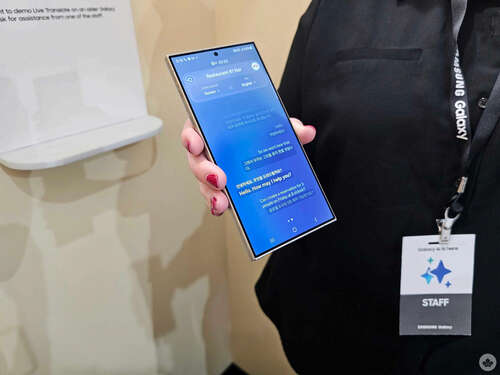
Circle to Search lets users hold down the home button, prompting a Google Search overlay. From there, you can circle or tap an object on your display with your finger or S Pen. For example, if you see a famous mountain in a friend’s picture, you can use Circle to Search to find the mountain and continue asking further questions, such as travel plans, the weather there for a certain time of year and more.
You can do this from any app, and since it’s using overlays, it’ll never kick you out of the app you’re using. This is a feature that looked really cool during Samsung’s demo. I’ll need to take a deeper dive into it, but I can see myself using this feature a lot.
The Interpreter is also a very interesting feature. It supports complete translation on-device for 13 languages, including French, Spanish, English and Korean. If you and someone who speaks another language are standing across from each other, you can use the Interpreter app and speak your native language. The handset will instantly translate speech into the desired language. While likely not a feature everyone will use, I can see it being useful while travelling or under certain circumstances. For example, my barber speaks mostly Spanish, so I’ll likely use Interpreter at my next appointment.
Another translation feature is Live Translate, which will let users speak to someone through the phone app in one language, and when they respond in another language, you’ll get live AI translation.
Samsung AI Keyboard
The Samsung Keyboard now has AI built into it. When you start composing a message with the Keyboard in any app, you can change the text’s tone, making it more professional or polite. You’ll also be able to translate these messages into 13 languages.
Even more AI
Samsung Notes also has new features. In the app, you can turn on Note Assist, allowing users to summarize notes, transcribe them into different languages, format them into bullet points, or the opposite, take a lot of bullet points and quickly summarize them. This feature goes hand-in-hand with the Transcript Assist for voice recordings. You’ll get a transcription of your recordings with up to 10 speakers, similar to Google’s own voice recording app. Samsung’s app can also offer summaries of recordings, something that has also recently come to Google’s Recorder app.
What I like about these new AI features is that they aren’t just gimmicks. Consider the LG G8′s ‘Air Gestures’ or even the Galaxy S23 Ultra’s ‘Space Zoom;’ they’re not features I would ever use daily and feel more like gimmicks designed to sell Samsung smartphones. What’s different with Samsung’s Galaxy AI is that these features immediately seem useful, and their user interfaces are intuitive and easy to use. I’ll need to put these features to the test, but based on my initial time with them, I’m impressed.
AI Camera features
Samsung also brought AI to the Galaxy S24’s camera editing. With Galaxy AI editing tools, you can use generative AI to adjust the position of subjects, blend and fill in backgrounds, remove shadows, remaster images and more. This feature seems similar to Google’s Pixel 8 Pro ‘Magic Edit,’ but works quicker and more accurately than Google’s AI editor. Plus, it has suggestions that are actually useful.
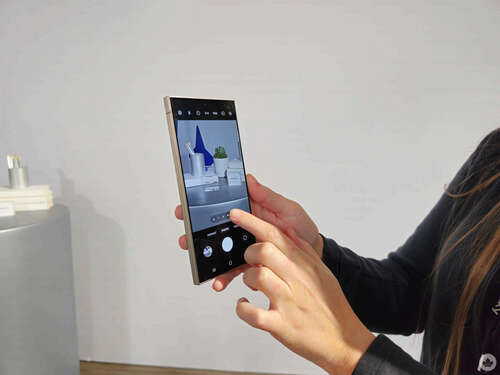
Instant Slow-mo is also impressive, allowing users to slow down select video parts, even if they didn’t film it in slow-mo. It generates additional frames based on the movements to make the slow motion even smoother and more detailed. This demo was pretty cool, and I look forward to trying it out more as well.
That’s AI folks
The Samsung Galaxy S24 Ultra starts at $1,799 in Canada and comes in ‘Titanium Violet,’ ‘Titanium Yellow,’ ‘Titanium Black’ and additional Samsung Store exclusive colours, including ‘Titanium Green,’ ‘Titanium Blue’ and ‘Titanium Orange.’
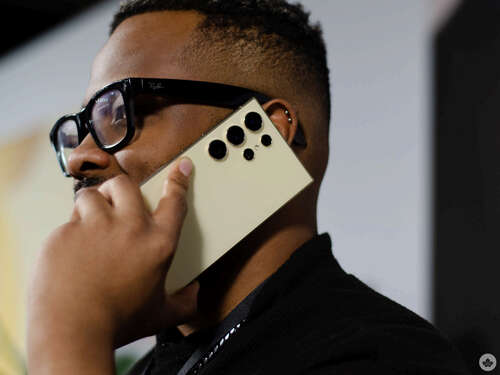
The Galaxy S24 starts at $1,099, and the S24+ at $1,399. Both handsets come in ‘Onyx Black,’ ‘Marble Gray,’ ‘Cobalt Violet,’ ‘Amber Yellow,’ and Samsung Store exclusive colours, ‘Jade Green,’ ‘Sapphire Blue’ and ‘Sandstone Orange.’
There’s a lot to test out for the first time in several years with the Galaxy S24 series, and I’m pretty excited to try out the S24 Ultra. Samsung’s new Galaxy AI features seem useful and could make my day-to-day easier. A full review of the Galaxy S24 Ultra will hit MobileSyrup in the coming weeks after I’ve spent more time testing out the smartphone.
For all of our Galaxy Unpacked 2024 coverage, follow this link.
MobileSyrup utilizes affiliate partnerships. These partnerships do not influence our editorial content, though we may earn a commission on purchases made via these links, helping fund the journalism provided free on our website.
